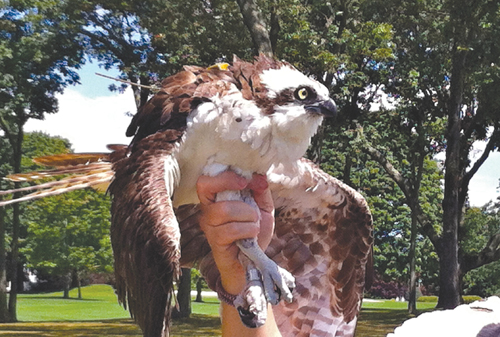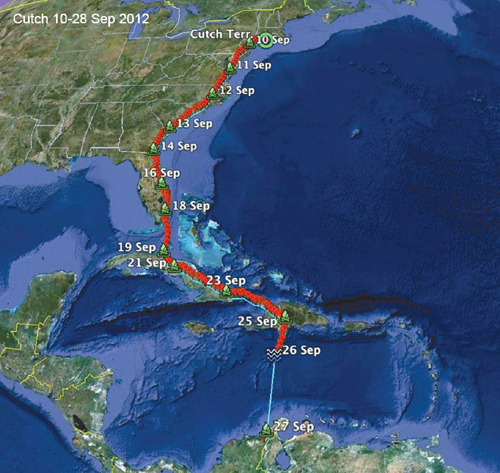GPS-tagged Osprey meets an ignoble end

After their winter in southern climes, the ospreys have returned, with one notable and unfortunate exception.
Cutch, an osprey tagged by an ornithologist at the University of North Carolina with a GPS device and tracked on his long migratory sojourns for the past few years, vanished last fall. He made it as far as Colombia, South America, where he died while doing what osprey’s instinctively do, that is hunt for fish.
Cutch, so named because he was caught and tagged behind the fifth hole of the North Fork Country Club in Cutchogue, met his demise when he was accidentally impaled on a piece of a tree protruding from a pond on the Chico Mono Ranch, said ornithologist Rob Bierregaard, who for 12 years has been tracking osprey’s flight paths to learn about their southern migration patterns,. He started tracking North Fork ospreys in 2010.
Ospreys fly south during their first autumn, spending their winters as juveniles in the warmer climate and building up strength to make their way north to breed. They return to the same area every winter.
Cutch, Mr. Bierregaard’s latest tagged osprey, left Long Island on Sept. 10 and followed the East Coast to North Carolina. In just one day, Cutch covered 286 miles to reach South Carolina, and he reached Florida by Sept. 18. He then zipped thorough Cuba, bypassing the first of many threats, according to flight path information on Mr. Bierregaard’s website.
“In Cuba they have to avoid fish farms, which is tough,” Mr. Bierregaard said. “It’s like telling me not to go to the all you-can-eat buffet. Fish farmers are not keen on sharing their fish with osprey.”
Next Cutch crossed the island of Hispaniola, through Haiti to the Dominican Republic, and from there across the Caribbean. He made landfall in Colombia southwest of the Guajira Peninsula, South America’s northernmost point, by Sept. 27.

On Sept. 29 Cutch’s signal stopped moving, suggesting his untimely demise, Mr. Bierregaard said.
“I zoomed in on the Google search, I could see the transmitter was at a building on the edge of a town in Colombia,” Mr. Bierregaard said. “I thought he was shot and someone took the transmitter.”
Mr. Bierregaard said he posted the details on his website, asking if anyone knew anything about the area.
“Someone figured out that it was the office of the Colombian Fish and Wildlife Service,” he said. “They had the bird and they emailed me pictures within an hour and a half of my sending the notice out.”
The osprey’s story was just beginning to get out, and it soon went national, making the evening news on Colombia television, Mr. Bierregaard said.
The news reported that Cutch’s death was originally thought to be an “assassination” but turned out to be an “accidental suicide,” the ornithologist said.
He called Cutch’s demise “a total fluke. We’ve had fluke accidents before, but skewering yourself on a submerged snag is a new one.”
Cutch, he said, “was pretty neat. He was a young bird that I believe had been born two years before.”
The bird is likely the offspring of the osprey he tagged in 2011 and named Tucker, Mr. Bierregaard said.
“He would have been Tucker’s young. He was hanging around the nest and the parents didn’t seem to be vicious toward him. He came back to the nest and that’s the behavior of a bird on his first year.”
As luck would have it, Cutch’s father Tucker met a similar fate — he was killed after hitting a bus just a month after he was tagged in 2011, Mr. Bierregaard said. Tucker’s mate was able to raise Cutch solo.
Cutch was caught for tagging in the same fashion as Mr. Bierregaard’s other ospreys. He was tempted by a whole sea bass that researchers had put in a nest at the country club.
When Cutch dove to grab the fish, his talons became caught in what Mr. Bierregaard calls a noose blanket, fishing line and rubberized chicken wire.
“Once he was stuck in the nest, I put a hood over his head, and that actually calms him down,” Mr. Bierregaard said. “It takes me about 40 minutes to put on the transmitter.”
Mr. Bierregaard tagged his first North Fork bird, known as North Fork Bob, in early August 2010. Bob has been going strong ever since. Mr. Bierregaard said.
Bob hasn’t yet returned, but he’s on his way.
“He left five days earlier than prior years” said Mr. Bierregaard. “He left on the 15th and the previous years he left on the 20th. So my guess is he’ll be back around the first or second of April.”
See an account of Cutch’s last flight at http://www.bioweb.uncc.edu/bierregaard/maps12/Cutch%202012.htm








